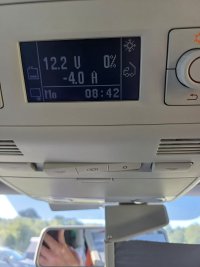Have a look at your history on the app (trends I think it's called) and set it so the two plots are panel wattage and battery voltage. The trend you expect to see (while the van is parked and the engine isn't being ran and when NOT on hookup) is a gradual decay in battery voltage overnight with solar dropped to 0W, then as light dawns the panel wattage will gradually increase, as will voltage, wattage will probably undulate a bit depending on weather until the battery reaches float, the the voltage will drop to float voltage (13.4/13.5v or something I think from memory) and the wattage will also drop to whatever is needed to sustain that voltage (if no draw on the system, it'll be something like 4W, the fridge on will cause "spikes" as the fridge cycles on/off as the thermostat does its thing).
Anyway, long story short, the above will tell you when the panel is doing what it is supposed to be doing. If you scroll back far enough to when you were having difficulties, look to see what happened during and after your journey away from that location; if the wattage spikes once you were moving (assuming daytime) and the pattern is more normal once at the other end, to me that points towards a bad connection somewhere that driving "jiggles" it about, so when you come to a stop sometimes it's ok, sometimes it isn't. I had this exact situation (in my case, the battery earth clamp had come loose somehow, there was also a bit of insulation trapped under it on the spade connector, so I stripped the insulation back a bit and redid the connection) and it resulted in a hard-to-believe 1v difference. Turns out the bad connection was increasing resistance and giving duff readings to the solar controller. Until then I'd assumed this sort of pretty basic wiring was pretty binary in that it either worked or it didn't, but it turns out there are other possibilities.
At the end of the day, the solar panel, MPPT and battery themselves are very unlikely to be "wrong" as in defective, along with the overhead display in the van itself. The next most reliable are the fuses; yes they can go, but I don't think it's as common you might think. That leaves the most likely culprit which is the wiring itself, more specifically anything added or modified as part of the install. Again, wiring itself less likely than the connections . . . as I found out!
FWIW, I'm pretty thorough and have a basic grasp of electronics, yet it took me several attempts to get to the bottom of the situation. Eventually I lost patience and stripped the system totally and rebuilt it on a busy campsite in Annecy, much to the combined amusement and bemusement of other campers, but it has worked flawlessly ever since . .















